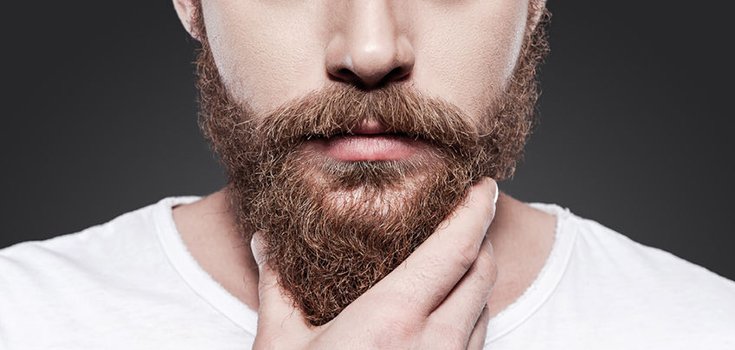Myth Busted: Beards are Cleaner than a Baby-Bottom Smooth Face

Some are disheveled, some are shaggy, and some are barely there. Beards are popular right now, much to many women’s dismay, and while beards sometimes catch soup and crumbs, they’re actually not unhygienic.
Adam Roberts, a clean-shaved microbiologist from University College London, decided to comb through guys’ facial hair to find out if they contain…poop. Not soup, but poop.
Oh, but beards are indeed a veritable petri dish, and what Roberts found could lead to a breakthrough in the global fight against antibiotic-resistant infections.
But let’s backtrack for a second.
The Internet is a good place to freak oneself out, which is where the story of poop-studying begins. Last spring, thousands, or perhaps millions, of readers nearly lost their lunch when a headlines like Some Beards Contain More Poo than a Toilet Shocking Study Reveals showed up.
Another microbiologist, John Golobic, of Quest Diagnostics in New Mexico, went fishing around in men’s facial fuzz searching for bacteria and supposedly found that while several beards contained normal bacteria, some contained so much poop that some of the whiskers’ owners would have been cleaner wearing a toilet bowl on their head.
The “study” wasn’t really a study though, at least not in the scientific sense. It was actually a project carried out by an Albuquerque-based TV journalist who swabbed a handful of men’s beards and then had Golobic examine the cultures. She found “enterics,” bacteria that are often found in the intestine, which are not the same as fecal matter. It’s fairly common for certain types of bacteria to be present in both the gut and on the skin, so the results weren’t as shocking as the headlines suggested.
The whole thing fascinated Roberts, who is part of a team of researchers working to discover new antibiotics that could fend off a worldwide drug-resistance crisis.
Roberts has spent the past year running the “Swab and Send” program, in which ordinary individuals submit swab samples from their surrounding environment to be tested for antimicrobial properties. He’s received samples from lots of unusual places, including from the inside of a toilet in a public restroom. So far, Roberts has isolated 20 promising strains capable of killing bacteria and yeast.

The Beard Swab
Roberts and his colleagues also swabbed the beards of 408 male hospital workers from 2 different teaching hospitals in 2013. Next the team compared the prevalence of certain bacterial strands in beards to the clean-shaven cheeks of their male hospital co-workers.
The hairless hospital workers were 3 times more likely to carry harmful bacteria, such as Staphylococcus aureus (MRSA), than their bearded counterparts. MRSA is a common and dangerous hospital-acquired skin infection that is resistant to many of the antibiotics used today.
Read: Manuka is Antibacterial, Antifungal, Kills Deadly MRSA Bacteria
“Our study suggests that facial hair does not increase the overall risk of bacterial colonization compared to clean-shaven control subjects,” the study’s authors wrote. “Clean-shaven control subjects exhibited higher rates of colonization with certain bacterial species.”
The team believes clean-shaven men harbor more harmful bacteria on their faces than bearded men do in their facial hair because of the “microtrauma” men experience when they shave. Those tiny and usually invisible repeated abrasions help bacterial colonies grow and spread on the skin.
Roberts found a presence of microbes in his swabs that appeared to destroy all other bacteria in the petri dishes. He isolated the microbe, placed it in a separate petri dish with E. coli, and found it was able to effectively kill the pathogen.
“Humans have used antibiotics pretty indiscriminately since we first discovered them, and we haven’t really found that many,” he said. “We’re relying on the few we have found over and over again, and that’s introduced a massive selection for resistant bacteria.”
The Discoveries of Antibiotic-Resistant Bacteria
We’ve written fairly extensively about the seriousness of ever-spreading drug resistance. This past fall, bacteria resistant to all antibiotics were found in China. That was in late November. By early December, the bacteria were detected in Denmark. They showed up in the United Kingdom in early January. Scientists were astonished by the rapid spread of the bug.
In mid-January, health investigators in Canada uncovered bacteria resistant to all drugs in that country in samples dating back to 2010, which lead researchers to wonder just how long the MCR-1 gene – the gene that makes bacteria resistant – has been in the mix.
Scientists have been pleading with the livestock industry and doctors to cut back on their use of antibiotics, warning that failing to do so could send medicine back to the Dark Ages.
Roberts and his fellow scientists will need to conduct a great deal more research in order to figure out exactly how the antimicrobial bacteria in some beards work and whether they’re effective against more serious, multi-drug-resistant strains, such as E. coli, MRSA, and Candida albicans, the source of yeast infections.
“It’s been dubbed a slow-onset disaster,” he said of antibiotic resistance, comparing antibiotic resistance to global warming. “You can kind of tell it’s happening, but nobody thinks they can do anything about it.”
“Every user of antibiotics in the whole world slowly increases the selective pressure [for resistance],” he said. “But every user also has the power to reduce that.”
Just think, hipsters and lumberjacks, someday your scruff could help scientists cure deadly illnesses. And hopefully your women will read this story and stop being turned off by your chin mop.
Sources:
